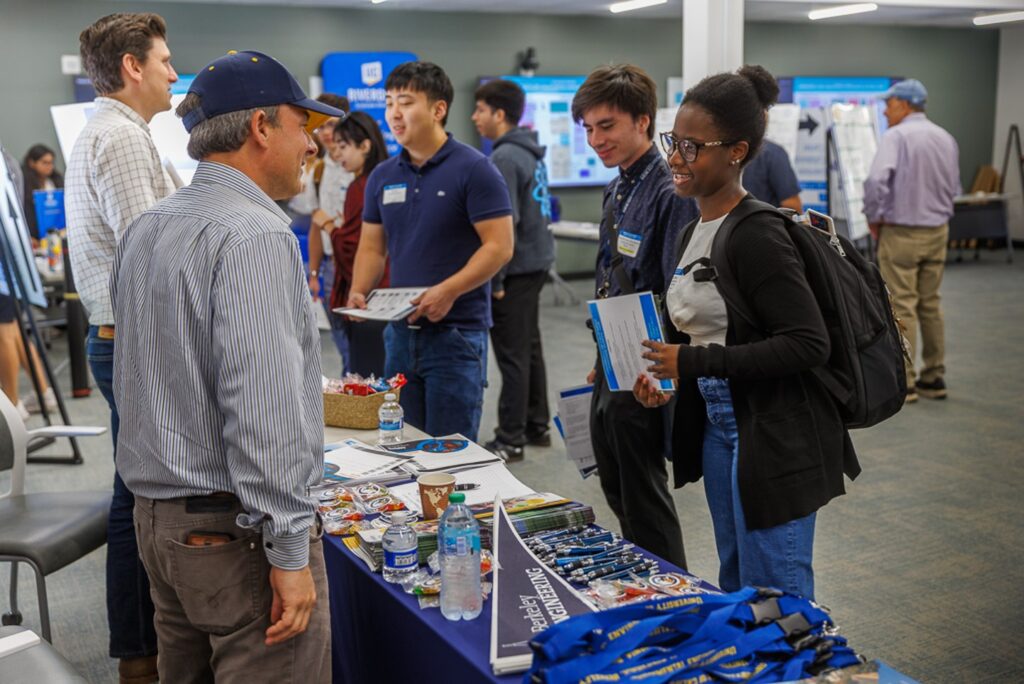By Caroline Liu (UCLCC Communications Intern 2025)
On July 8, 2025, the UC Livermore Collaboration Center (UCLCC) hosted its first ever UC Graduate School Fair. The event provided a rare opportunity to bring together representatives from nine University of California campuses, leaders from the Krell Institute and interns and employees from Lawrence Livermore National Laboratory (LLNL) and Lawrence Berkeley National Laboratory (LBNL). The day marked yet another way to leverage UCLCC’s ability to foster cross collaboration among the UC campuses and three National Laboratories – and, in turn, inspire the next generation of scientists and engineers.

Emphasizing The Fields That Will Lead the Future
The fair was especially focused on scientific and technological disciplines that will be essential in the near and long-term future, including engineering, physical sciences and high energy density science. The nine UC campuses (Berkeley, Davis, Irvine, Los Angeles, Merced, Riverside, San Diego, Santa Barbara and Santa Cruz) brought representatives from those and related fields, including deans, vice provosts, assistant and associate professors, graduate students and staff. They were joined by LBNL and LLNL employees and representatives from the Krell Institute, a non-profit organization that provides U.S. Department of Energy-funded graduate fellowships to support students interested in pursuing doctoral degrees in fields using high performance computing.
Throughout the day, laboratory interns and employees engaged one-on-one with UC campus representatives to discuss the resources and support available to pursue graduate studies. This included learning more about the graduate application process, scholarship and fellowship opportunities and other unique pathways to higher education.
The intimate setting also allowed attendees to get their questions answered, network with current UC faculty from the different campuses and see current graduate student’s research and individual paths to graduate school. De’ja Bailey, an LLNL intern, was grateful to have had the “opportunity to connect with lab staff, University of California representatives, and other student interns.”
Three Formal Sessions
In addition, to informal networking, the event held three formal sessions. The first focused on UC Admissions, scholarships and the lab’s Employee Tuition Assistance Program (TAP). People directly in charge of those programs provided in-depth information on graduate admissions and ways to help fund higher education, including financial assistance for those interested in pursuing higher education while working at one of the national laboratories.
The second session was a panel that sought to dispel the mysteries of graduate school. Faculty members and their graduate students shared their unique, often non-linear journeys. The pairings of professors with their students also allowed participants to see the mentor-student relationship, a key factor in shaping academic success. “I appreciate hearing people’s own experience and hearing their personal journey on how they got to graduate school,” said Sofia Malmhall, a second-year intern at LLNL.
At the third session, employees from LBNL and LLNL showcased their career paths as part of an effort to have the UC graduate students learn about career opportunities at the labs. During this session, the lab employees and graduate students also had the chance to spend time speaking more informally about research and career paths. “The UC Grad School Fair was such a great opportunity to connect with so many bright students and interns from diverse research backgrounds,” said Xiaoxing Xia, a staff scientist at LLNL who spoke as a panelist. “After the panel, I had great conversations with UC faculty members and fellow panelists, which sparked many ideas for new research collaboration as well as institutional partnership.”
The day concluded with a reception, providing yet another opportunity for participants to informally connect with each other, discuss their research and explore potential opportunities for collaboration. It capped a highly successful day, in which UCLCC’s three buildings, six conference rooms and expert staff facilitated the kind of synergistic effort that has been the goal of the facility since its inception.

